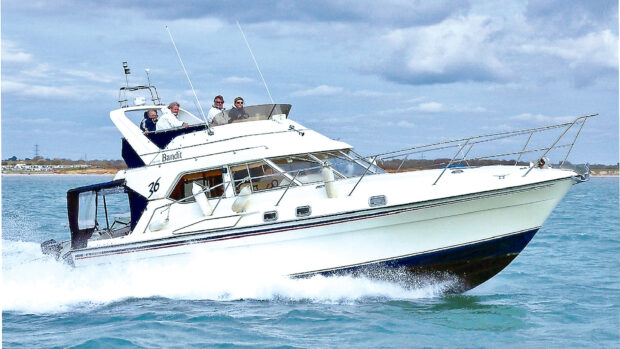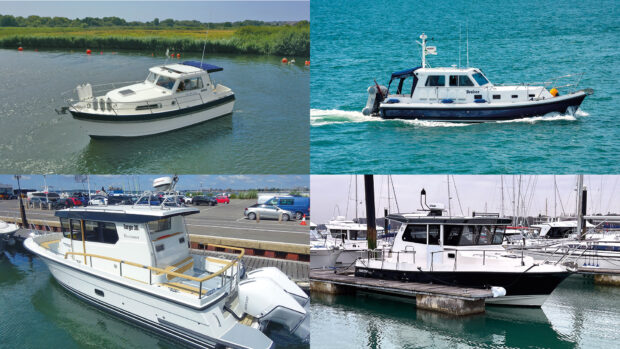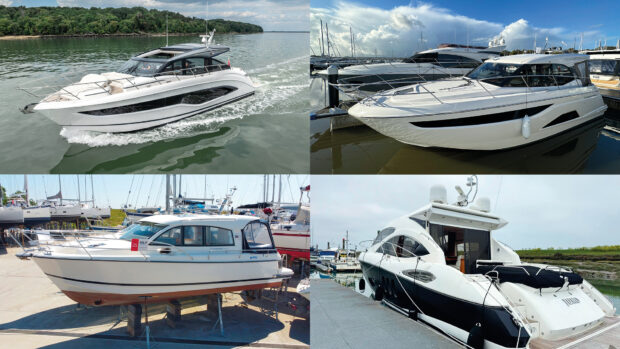When Beryl Chalmers and Simon Palmer decided to buy a boat that could cross the North Sea as well as cruise the waterways of Europe, it took them three attempts to find their perfect craft
There are boats for the inland waterways and there are sea-going craft. But we needed to find one that could do both. As both my husband, Simon, and I are retired, we like to spend five months of the year living and cruising on our boat.
Prior to 2020, we’d spend most of that time pottering slowly through the waterways of Holland on our comfortable Dutch steel cruiser. However, since Brexit restrictions came in, limiting us to 90 days in the EU in any 180-day period, we had to find something that would also be capable of crossing the North Sea in reasonable time and comfort.
It took us several attempts to find our perfect boat. First we bought a Beneteau Swift Trawler 44 – a lovely boat, originally built for the 2012 Olympics. Its twin 300hp engines and semi-displacement hull made light work of crossing the North Sea but at the cost of quite a lot of fuel.
Then there was the issue of its air draft, which at 12ft 8in with the mast folded was too high to fit under many of the bridges spanning the Dutch waterways. Reluctantly, we decided it wasn’t the right boat for us.

Greenline 39 hybrid was one of the options on the market
Next we tried a Greenline 39 Hybrid. Another fine boat but slightly tight for four people and not very easy to board or disembark. The electric folding transom, which had seemed such a great idea at the time, offering the benefit of an extended boarding platform without the increased berthing fees of a fixed one, actually proved to be its Achilles’ heel.
When boarding the boat, one of us would always have to climb over it before we could get to the button to lower it. There was no side gate allowing access from the pontoon and the bulwarks were simply too high to step over. A lovely boat but still not quite right for us.
Article continues below…

Best 40ft family flybridge boats on the market now

Best boats under £100,000 from the secondhand market
By this stage we were beginning to get a little desperate. Everything we looked at was either too small, too tall or simply too expensive. Yes, we were being fussy, but now we had the time, we wanted a boat that ticked as many boxes as possible without busting our budget.
For months we trawled the internet, avidly read every issue of Motor Boat & Yachting, and browsed every motor boat dealer’s website we had heard of in search of our Goldilocks boat.
In a final attempt to find that elusive do-it-all boat, we decided to visit the Düsseldorf boat show in January 2023 to try and view every 40ft motor cruiser on the market. Because of slight mobility difficulties, we really wanted a side boarding gate, something which very few craft seemed to offer at the time. It was here that we stumbled across the Delphia brand, a Polish yard now owned by the French Beneteau group.
This unashamedly value-for-money brand makes three different sizes of craft from 32ft–44ft, all of which come in a variety of different body styles (Sedan, Lounge and Fly Lounge). They were being marketed primarily as inland waterways craft, presumably because they have displacement only hulls, limiting them to a top speed of 9-10 knots, and can be fitted with all-electric drivetrains.

Delphia 11 Fly Lounge
Three’s a charm
But, and it was a big but, we discovered that they also offer conventional diesel engines. The 35ft Delphia 11 that best suited our requirements could be fitted with a 150hp Yanmar diesel engine, more than enough to push this 7.3-tonne boat across the North Sea.
And despite the focus on inland waterways cruising, it was RCD rated as Category B, meaning it should be capable of offshore passages up to and including Force 8 winds and 4m wave heights.
There was more. Previously, we had never even looked at flybridge models, assuming they would all be too tall, but the Fly Lounge version of Delphia’s 11 had an air draft of just 2.95m – less than our previous Dutch waterways cruiser.
Over the course of the next three days, we revisited the boat several times, checking measurements, comfort, storage, ease of handling systems and working out whether our dog could manage the steps to the flybridge! We also spent a considerable amount of time checking all the other stands too in case we’d missed any other possible contenders.

It has a door from the inside helm to the sidedeck and a gate next to it so you can step off onto the pontoon
There was nothing else out there that ticked all our boxes and we kept coming back to the Delphia. It has a door directly from the inside helm to the side deck and a side gate right next to it so you can step straight off onto the pontoon, making mooring very easy, even when single-handed.
It has two good double cabins and two heads, so we can have guests to stay without impinging on our privacy. It has a spacious indoor saloon, galley, dining area and helm station for comfortable liveaboard cruising, whatever the weather.
There is also a big aft cockpit, cosy bow lounge and a wonderful flybridge and outdoor helm for enjoying the sunshine when conditions allow. And thanks to that frugal Yanmar engine and simple shaft drive layout, it promised hours of reliable, stress-free motoring and a long cruising range without breaking the bank.
The price we were quoted for a brand new boat came to £363,000 inc VAT, plus another £15,000 for the extras we wanted. We came home buzzing with enthusiasm, laden with photographs and full of cruising plans but without having actually bought a boat.

The spacious saloon that helped win over Beryl and Simon
Not because we weren’t smitten by the Delphia but because we hoped to find a stock boat that would get around the waiting time for a new one to be built.
Being such a new model, there was only one for sale in the whole of Europe – a demonstrator model with 50 hours on the engine being offered by a Dutch dealer in Makkum.
It was only the third hull off the production line and would be available within a couple of months, in time for the summer season. We went to see it as soon as we could. This time there was no hesitation. We made an offer and she was ours.
She still needed a few changes to make her perfect, such as swapping the inverter for a Victron one so we could check on her battery status by remote; removing the optional wet bar from the transom to make space for a bike rack and dinghy storage, and changing the lowerable but heavy A-frame arch at the stern of the flybridge for a simple stern light pole. The original is designed to take a radar scanner but we didn’t intend to fit one – we didn’t want the hassle of having to lower it every time we went under a bridge.

The boat promised hours of reliable, stress-free motoring and a long cruising range without breaking the bank
Going Dutch
By summer, the work was complete and since we’d just returned from a trip to New Orleans to take part in the Mardi Gras celebrations, we named her Mardi Gras. We picked her up from the dealer in Makkum, but rather than take her straight home, we spent seven weeks exploring Friesland, enjoying the Marrekrite wild moorings, then crossing the Markermeer before heading south to make the crossing to the UK.
We tend to use the smaller canals, where possible, for the beautiful towns and scenery, and to avoid the big commercial barges, which can be quite daunting when they are bearing down on you in the bigger canals.

The steps up to the flybridge are fine for human guests but their dog has found an even quicker route!
We stopped off at Monnickendam, one of the hundreds of beautiful Dutch towns near Amsterdam, then to Weesp, down the Vecht towards Utrecht, and then to Gorinchem in south Holland. We planned to visit the Big Rivers festival in Dordrecht (150 bands playing in the city over three days) before heading further south to Vlissingen where we would cross over to the UK.
We had been watching for a weather window for our North Sea crossing and when one opened up earlier than expected, we decided to forego the festival to take advantage of the settled weather. Mardi Gras had never seen the North Sea before, and despite being a Category B, we didn’t want to test her limits yet.
North Sea crossing
In the end, the crossing went very smoothly. A fairly quiet sea, little wind and a trusty engine purring away beneath our feet as we cruised along at a steady 8-9 knots. The trip back to Mersea Island just south of Harwich, took us less than 11 hours.
A big bonus for us, and a largely unexpected one, has been helming from the flybridge. It really is a pleasure and makes berthing in close quarters very simple as you can look over the starboard side and position her exactly where you want to for the crew to step off and tie up. And it is such a big entertaining space – at one point we had 14 people seated up top to celebrate a birthday. There is even a fridge drawer up there, so we don’t even have to go below for the next round.

After three nights in the capital, we passed under Tower Bridge – another box ticked off the bucket list
After a couple of months pootling about the east coast, we then joined a cruise in company from West Mersea Yacht Club to St Katharine Docks, London. There is something very special about mooring next to Tower Bridge in the centre of London with a group of like-minded boat owners.
After three nights in the capital, we then passed under Tower Bridge – another box ticked off the bucket list – then Hammersmith bridge, the lowest bridge in London at 3.6m at high water, and on to the non-tidal Thames at Teddington.
All went fairly smoothly, although some of the side currents needed careful navigation through any arched bridges. Paying our £267 licence at Teddington to use the river for one month, we then proceeded to all the iconic places to be found on the Upper Thames such as Windsor Castle, Hampton Court Palace and Henley.
Encountering a broken lock at Chertsey forced us to make a decision – stay for the winter further along the Thames until the lock was repaired or go back to the east coast. We chose to stay, mooring at the Delphia dealership, Tingdene Marina near Reading.

Beryl Chalmers and Simon Palmer
Season by numbers
We added just over 200 hours to the engine in our first season, cruising most of the length of Holland then across the North Sea and up the Thames to Reading, using just under £1,400 worth of fuel and averaging 5.3 litres per hour. During that time we enjoyed just over five months living on board and exploring the many delights of life afloat in the UK and EU.
Oh, and the dog found its own way to get up and down from the flybridge, jumping straight from the foredeck up and over the windscreen – the ultimate seal of approval!









